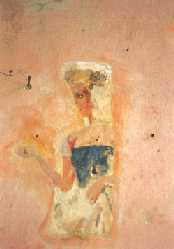A Theft of Bruno Schulz Frescos
Photo by
 On
May 21, 2001 the frescos created by writer, philosopher and artist Bruno
Schulz during his last months of life disappeared from the villa where
Gestapo officer, commissioner in Jewish affairs Felix Landau lived during
the occupation period. In three days they were dismantled skilfully from
the walls of the apartment where now two old spouses live who received
100 USD for the disturbance. As it was clarified later, the frescos has
been dismantled and transferred to Israel by the group of specialists
from “Yad Vashem” Institute, Jerusalem. Institute speaker Iris Rosenberg
answering on the requests of illegal displacing of Ukrainian cultural
heritage mentioned that the group of conservators led by Marc Schreiberman,
“Yad Vashem” officer had a grant paper from the apartment owners (though
not certified by the lawyer) and the official permission of Drohobych
city authorities. The Mayor of Drohobych O.Radzijevskyj however objects
his engagement to this deal. It is not clear yet how did the precious
pieces cross the Ukrainian border - through the customs or by diplomatic
channels, what can point to the kind of crime committed: theft, corruption
or both. Lviv Art Gallery Director Mr.Voznytskyj invited the independent
experts from Poland (particularly the National Museum conservator Mrs.
Agnieszka Kijowska who was the first person to open the first hidden fragments
of the frescos) for the exact evaluation of damages caused by dismantling
(thestolen pictures has been dismantled from two walls of the children
room, though there could be some on the third wall and somewhere else
in the villa still hidden under the plaster layer). Just recently before
the theft of the frescos the Krupp Foundation (Germany) has declared the
donation of 300 000 USD in order to buy new flats for inhabitants of five
apartments of the villa and to create a Reunion and Reconciliation Centre
in its rooms to which Memorial Museum of Bruno Schulz, Centre for interethnic
relations studies in Drohobych and the small hotel for the foreign specialists
who would study and multiply the multi-cultural Galician heritage, should
be included.
On
May 21, 2001 the frescos created by writer, philosopher and artist Bruno
Schulz during his last months of life disappeared from the villa where
Gestapo officer, commissioner in Jewish affairs Felix Landau lived during
the occupation period. In three days they were dismantled skilfully from
the walls of the apartment where now two old spouses live who received
100 USD for the disturbance. As it was clarified later, the frescos has
been dismantled and transferred to Israel by the group of specialists
from “Yad Vashem” Institute, Jerusalem. Institute speaker Iris Rosenberg
answering on the requests of illegal displacing of Ukrainian cultural
heritage mentioned that the group of conservators led by Marc Schreiberman,
“Yad Vashem” officer had a grant paper from the apartment owners (though
not certified by the lawyer) and the official permission of Drohobych
city authorities. The Mayor of Drohobych O.Radzijevskyj however objects
his engagement to this deal. It is not clear yet how did the precious
pieces cross the Ukrainian border - through the customs or by diplomatic
channels, what can point to the kind of crime committed: theft, corruption
or both. Lviv Art Gallery Director Mr.Voznytskyj invited the independent
experts from Poland (particularly the National Museum conservator Mrs.
Agnieszka Kijowska who was the first person to open the first hidden fragments
of the frescos) for the exact evaluation of damages caused by dismantling
(thestolen pictures has been dismantled from two walls of the children
room, though there could be some on the third wall and somewhere else
in the villa still hidden under the plaster layer). Just recently before
the theft of the frescos the Krupp Foundation (Germany) has declared the
donation of 300 000 USD in order to buy new flats for inhabitants of five
apartments of the villa and to create a Reunion and Reconciliation Centre
in its rooms to which Memorial Museum of Bruno Schulz, Centre for interethnic
relations studies in Drohobych and the small hotel for the foreign specialists
who would study and multiply the multi-cultural Galician heritage, should
be included.